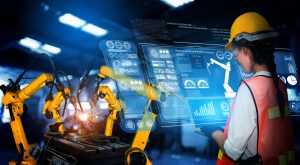Computer-aided design (CAD) models have been used to design, simulate, and manufacture parts, products, machines, subsystems, and systems for decades, perhaps most famously when the 1980’s-era Boeing 777 was the first jetliner to be 100% digitally designed. A more recent evolution of digital modeling is widely known as virtual twins or digital twins, where digital objects or complete mechanisms and systems are created by gathering real-world usage data and applying that data to the CAD model. The virtual twins constantly get updated with data from the real objects through a wide variety of sensors and related web-connected technologies that power the internet of things (IoT) and industrial internet of things (IIoT). This combination brings a digital representation of object and its surrounding environment into software platform, and unlocks a variety of possibilities for product designers and manufacturers alike.
Long Term and Real-Time Benefits
Since the virtual twins can capture all functional operations – such as performance, failures, maintenance requirements, etc. – these models can be holistically analyzed. This analysis provides opportunities for optimizations and performance improvements using predictive analytical models, big data analytics, edge computing, cloud computing, artificial intelligence (AI), and more. Engineers and decision makers can use the results of these analyses to optimize the functionalities of the real objects and maintain their operations at peak performance. Businesses can monitor the operations and processes of a virtual twin in real-time to make relevant adjustments, and closed-loop control systems can be used for automating the processes and continuous improvements.
Notably, since the virtual twins can be used to predict the behavior and response of the real objects under specific conditions, any potential changes for optimization can first be applied to the virtual twins to study the results. Using virtual twins as a “test lab” for optimization before applying the changes to real objects eliminates time-consuming and costly real-world experimentation.
The level of accuracy between a virtual twin and the real object depends on the quantity and quality of data gathered from the real object and its surrounding environment. The amount of data depends on the number of sensors that are used, and the quality of data depends on the precision and performance of the sensors.
Advances in IIoT and sensor technologies are making the virtual twins ubiquitous across industries transportation, construction, retail, and energy, simulating everything from airplanes and wind turbines, to entire cities and human organs. But virtual twins are making the biggest impact in the manufacturing sector, where companies are deploying virtual twins at all levels of their organization.
Unlocking the Potential of Manufacturing
Examples include developing virtual twins for individual spindles, bearings, gearboxes, lubrication mechanisms, or pumps. But the virtual twin

provides the most value when simulating systems within systems, like the complex interactions between robots, manufacturing cells, production and assembly lines, , energy systems, environmental conditioning systems, and supply chain systems. Indeed, the truly transformative enterprises are creating virtual twins of their entire factory, including the supply chain, and the operational processes across the corporate enterprise.
Just imagine how products can be improved and operations can be kept at peak performances when virtual twins are deployed across a manufacturing organization. This will dramatically reduce downtime, energy consumption, and maintenance costs, while improving efficiency, agility, customer service, safety, and more. For most manufacturers, adopting these boosts to flexibility and product quality are imperative to staying competitive.
Demand for innovative products that create higher and higher value for the end users is rapidly increasing. Consumers are becoming more conscious about the value they get from the products they want to buy. This has resulted in an ever-increasing competition among product development and manufacturing companies to sustain and improve their market share. In order to keep up with the increasing consumer demands for innovative products and stay competitive, product development cycles needs to get shorter and shorter, and agility and flexibility should be increased within the entire product development and manufacturing ecosystem. Businesses must be able to pivot based on this dynamic of new consumer demands and market needs. Virtual twins of manufacturing floor and processes can greatly address this.
Deploying virtual twins of manufacturing floor and processes enables businesses to enjoy the advantages of lean manufacturing software methodology at a dramatically higher level. The 5S system has been used in manufacturing to reduce waste, increase safety, make workplace clean and organized, and make operations smooth. It will increase the product quality and the overall return on investment (ROI).
Virtual twins of manufacturing floor will take the advantages of the 5S system to the next level by significantly increasing visibility and real-time

planning. Also, just-in-time production system has been used in manufacturing to minimize inventory and produce products only when there is demand for it. It allows you to dedicate your resources to what matters most in creating a higher value for consumers as well as for your company. It enables manufacturers to create a pull system. Virtual twins of manufacturing processes will greatly increase the smoothness of the production flow as well as the resource planning effectiveness that are associated with the just-in-time system and pull system. These are just a few examples of advantages of virtual twins of manufacturing floor and processes. Virtual twins in many ways improve overall effectiveness, efficiency, productivity, and built-in quality in manufacturing.
Digital technologies are shaping the new face of manufacturing. They dramatically improve the human-machine efficiencies. Virtual twins take engineering, design, manufacturing quality control software , assembly, inventory, supply chain planning and optimization, and other important aspects related to decision-making process to the next level of efficiencies. Companies that effectively implement virtual twins will have a competitive advantage, and since virtual twins can be tailored to fit the needs of most organizations, manufacturers of all sizes should add virtual twins to their digital transformation plans.
##
Editor:
Join Dassault Systèmes North America for 3DEXPERIENCE FORUM 2021. Our 1-Day virtual event launching on September 9th will examine the business, societal and consumer impacts brought about by a fast-changing global environment, and inspire and enable manufacturing leaders to drive growth and sustainable innovation to meet current challenges and pivot towards future opportunities.
Registration also includes access to 3DEXPERIENCE Dialogues – our focused topic roundtables taking place Sept. 21-23 featuring influencers and customers focused on complex challenges, future outlook, and practical solutions for post-pandemic innovation. Dr. Hassan Rashidi will participate in September 23rd session on V+R. The full schedule includes:
- Sept. 21: The Unsung Technology Hero behind Product Innovation.
- Sept. 22: Digital Transformation-Where Do We Go From Here?
- Sept. 23: How Manufacturing Success starts with Virtual + Real Operations featuring Dr. Hassan Rashidi.
